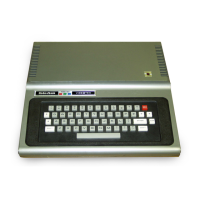OPERATION
4
/
Using the
Keyboard
The keyboard allows entry
of all the standard text and
control
characters.
As
with
ordinary typewriters, use (SHIFT) to enter the
upper
symbol
on
those keys contain-
ing two symbols. For example,
to
enter a"!",
press (SHIFT)
CD-
Capitals and
Lower Case
(SHIFT)®
The
A-Z
keys can produce
either upper or lowercase
characters. There are two
modes of operation: CAPS, in
which the A-Z keys
always produce capital letters; and
ULC
(upper/lowercase), in
which the
A-Z
keys produce
lowercase unless
you
press
(SHIFT)
.
When
you
start
the Computer, the keyboard
is in the CAPS mode. To
switch
to ULC,
press (SHIFT )(B). To
switch back, press (SHIFT) OS)
again. (SHIFT)
(0)
is a "toggle":
each time
you
press it, you
switch from one mode to
the other.
Special Keys
Certain keys
have special functions in BASIC.
Rather than accepting
them as
keyboard data, BASIC
performs the
specified function.
Function
Key
©
©
(MED©
(SHED©
(SHIED®
(ENTER)
(CLEAR)
Backspaces and erases the
last character typed.
Tabs over to
the next eight-column
boundary.
Starts over
at the beginning of the
line.
Converts
to
32
characters/line.
Pauses program
execution. Press any key to
continue.
Enters the line. BASIC
will not interpret a line until you
press
dNjjR).
Cancels the
current line, erases
the display, converts
to
64
characters/line,
and positions the
cursor
to
the upper
left corner
("home").
19

